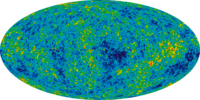
Photo from wikipedia
Recent studies have presented evidence for tension between the constraints on Omega_m and sigma_8 from the cosmic microwave background (CMB) and measurements of large-scale structure (LSS). This tension can potentially… Click to show full abstract
Recent studies have presented evidence for tension between the constraints on Omega_m and sigma_8 from the cosmic microwave background (CMB) and measurements of large-scale structure (LSS). This tension can potentially be resolved by appealing to extensions of the standard model of cosmology and/or untreated systematic errors in the modelling of LSS, of which baryonic physics has been frequently suggested. We revisit this tension using, for the first time, carefully-calibrated cosmological hydrodynamical simulations, which thus capture the back reaction of the baryons on the total matter distribution. We have extended the BAHAMAS simulations to include a treatment of massive neutrinos, which currently represents the best motivated extension to the standard model. We make synthetic thermal Sunyaev-Zel'dovich effect, weak galaxy lensing, and CMB lensing maps and compare to observed auto- and cross-power spectra from a wide range of recent observational surveys. We conclude that: i) in general there is tension between the primary CMB and LSS when adopting the standard model with minimal neutrino mass; ii) after calibrating feedback processes to match the gas fractions of clusters, the remaining uncertainties in the baryonic physics modelling are insufficient to reconcile this tension; and iii) invoking a non-minimal neutrino mass, typically of 0.2-0.4 eV (depending on the priors on the other relevant cosmological parameters and the datasets being modelled), can resolve the tension. This solution is fully consistent with separate constraints on the summed neutrino mass from the primary CMB and baryon acoustic oscillations, given the internal tensions in the Planck primary CMB dataset.
Journal Title: Monthly Notices of the Royal Astronomical Society
Year Published: 2018
Link to full text (if available)
Share on Social Media: Sign Up to like & get
recommendations!